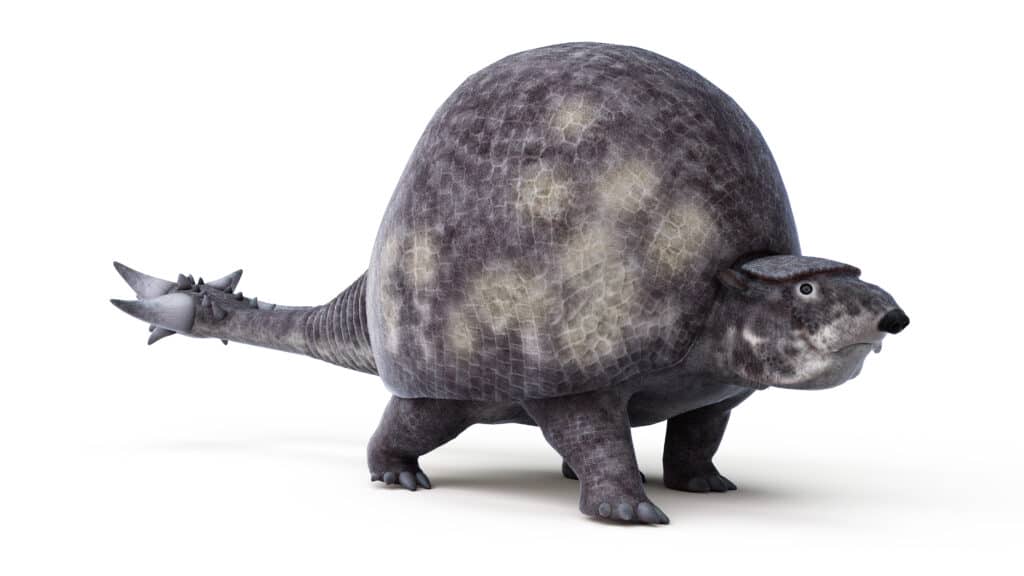Doedicurus
Doedicurus clavicaudatus
Deodicurus was one of the largest glyptodonts to have ever lived.
Advertisement
Doedicurus Scientific Classification
- Kingdom
- Animalia
- Phylum
- Chordata
- Class
- Mammalia
- Order
- Cingulata
- Family
- Chlamyphoridae
- Genus
- Doedicurus
- Scientific Name
- Doedicurus clavicaudatus
Read our Complete Guide to Classification of Animals.
Doedicurus Conservation Status
Doedicurus Facts
View all of the Doedicurus images!
Doedicurus is an extinct genus of heavily-armored armadillos native to South America. The genus has only one species; D. clavicaudatus. It belongs to the family Chlamyphoridae, along with the modern armadillo species. They lived during the Pleistocene and survived until about 7000 years ago.
Description & Size

On average, the Doedicurus was nearly five feet tall and 12 feet long.
©SciePro/Shutterstock.com
Doedicurus is a genus of extinct mammals that belong to a group of heavily armored armadillos collectively referred to as the glyptodont. Animals in this group have a characteristically rotund shape with a heavy armor carapace covering their dorsal section. The Doedicurus is one of the largest members of this group to have ever lived. The genus name means club-tailed or pestle-tailed in the Ancient Greek language.
On average, the Doedicurus was about 4 feet 11 inches tall and was roughly 12 feet in length. It weighed as much as 3,100 pounds on average. However, scientists believe that the Doedicurus grew even bigger shortly before it became extinct. Thus, later specimens could have weighed as much as 4,190 to 5,220 pounds.
Like other glyptodonts, Doedicurus had a domed carapace on its back. This was made from tightly fitted scutes similar to that of present-day armadillos. The huge carapace was snug at the pelvis but was loose around the shoulder. Experts think the dome might have been fat-filled like the hump of a present-day camel. Doedicurus were naturally quadrupeds. However, like other large glyptodonts, the Doedicurus could stand on two legs.
Another notable physical feature of the Doedicurus was their spiked tail club which weighed between 88 to 143 pounds. The tail club was up to 3-feet-3-inches in length. Scientists think it would have been a potent weapon that the Doedicurus could swing at high speeds of up to 25 miles per hour at opponents.
Diet – What Did Doedicurus Eat?
Doedicurus was most likely a grazer that fed on low-growing grasses or multicellular organisms like algae. However, this glyptodont’s dentition and mouth seemed like they were not well adapted to chewing grass effectively. This means the Doedicurus would have had a slow metabolism.
Habitat – When and Where It lived
Doedicurus lived in open grasslands and woodlands. During the Pleistocene, the climate was temperate or cool. The distribution of the genus was restricted to a cold, humid region in the southern end of South America. The climate at the time was characterized by cycles of cold and warm climatic conditions. These are known as glacial and interglacial periods. The glacial periods would have had a lot of savanna land, while the interglacial cycles would have had rainforests and woodlands.
Threats And Predators
Considering the size of the Doedicurus and heavy armor, it wouldn’t have been top on the menu of the predators that lived around the same time. The genus was also isolated on the South African continent for a long time. The most dominant on the continent at the time include the terror birds, madtsoiid snakes, and sebecid crocodylomorphs,
However, the formation of the Isthmus of Panama (a landbridge that joined South America and North America) allowed new predator species to move into South America during the Great American Interchange.
This period would have brought the Doedicurus in contact with many large mammalian carnivores that were not native to South America. This includes the saber-toothed tiger, short-faced bear, and the jaguar. In addition to these predators, the interchange also allowed the migration of large herbivorous mammals, deer, elephants, tapirs, and horses that would have competed for grazing land.
Contrary to expectations, experts think the tail club of the Doedicurus was not an adaptation for fighting off predators. Instead, they probably used it for intraspecific battles as part of their mating behavior. Humans would have been one of the biggest threats the Doedicurus faced during the Quaternary.
Discoveries and Fossils – Where Doedicurus was Found
British Paleontologist Richard Owen published the first description of the Doedicurus Owen in 1847. It was the 5th glyptodont species described at the time. The fossil was a partial tail showing the massive club. Initially, Owens assigned the new species to the Glyptodon genus. However, in 1874, the animal got classified into its own genus.
Extinction – When Did It Die Out?
Doedicurus was most likely the last surviving member of the glyptodont group. Fossil records suggest that they might have lived till about 8,000–7,000 years ago. Like many of the extinct megafauna that lived around the world at the time, the genus went extinct during the extinction event that took place during the Quaternary. This extinction event was caused by climate change and overhunting by humans.
Related Animals…
View all 110 animals that start with DDoedicurus FAQs (Frequently Asked Questions)
What is the armadillo dinosaur called?
Glyptodonts like the Doedicurus are sometimes referred to as armadillo dinosaurs. These giant mammals were not actual dinosaurs. They’re related to modern-day armadillos and have been found in fossil records dating back to the Pliocene and Pleistocene Epochs (5.3 million to 11,700 years ago)
How did Doedicurus become extinct?
The Doedicurus lived in the Quaternary and went extinct about 7000 years ago. The prevailing theory for their extinction is that they may have disappeared due to climate change and overhunting by humans.
When did Doedicurus go extinct?
The Doedicurus disappeared from fossil records during the Pleistocene Epoch. This was around 10,000 to 7,000 years ago. However, some theories suggest it might have survived till about 45,00 years ago.
What did the Doedicurus eat?
Doedicurus was a grazer, feeding on grasses and low-lying plants. The dentition and shape of the mouth suggest that it was a bulk feeder.
Thank you for reading! Have some feedback for us? Contact the AZ Animals editorial team.
Sources
- Wikipedia / Accessed October 13, 2022
- Definitions / Accessed October 13, 2022
- Wikipedia / Accessed October 13, 2022
- Thought Co. / Accessed October 13, 2022


















